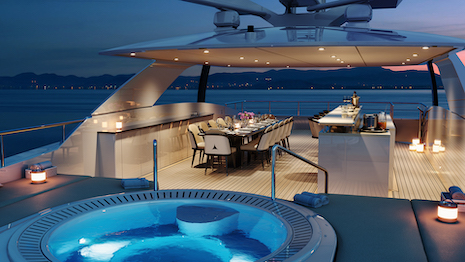 Evening scene on the sundeck of Heesen's YN20750 Project Orion superyacht. Image: Heesen
Evening scene on the sundeck of Heesen's YN20750 Project Orion superyacht. Image: Heesen
The global superyacht market, buoyed by the growing number of ultra-high-net-worth individuals interested in the sailing life, is estimated to reach $25.68 billion by 2032, up from $10.3 billion in 2022.
That estimate reflects a compound annual growth rate of 9.8 percent from 2023 to 2032, according to a new report from Allied Market Research that covered 14 countries.
“The growth of the global superyacht market is determined by the growing wealth of ultra-high net-worth persons, the rise of a prominent destination for luxury yachts, and increasing tourist attractions and luxurious hotels that are anticipated to drive the market,” per the report.
“However, factors such as environmental concerns related to fuel consumption and emissions and retaining qualified and experienced crew members restrain market growth.
“On the contrary, the growing demand for electric yachts and customization in luxury yachts are expected to provide lucrative growth opportunities for the market growth.”
Big is beautiful
A superyacht refers to a luxurious large yacht of more than 30 meters in length. Such vessels have a high-end recreational purpose, owned mostly by UHNWI.
Superyachts differ considerably in size, design, luxury accessories and quality of workmanship. They come with numerous accessories, including many decks, pools, helipad, Jacuzzi and gym.
These ships normally have a well-trained crew such as a captain, officers, chef and other support staff.
The superyacht market share is slightly fragmented among players including Damen Yachting BV, Azimut Benetti Group S.p.A., Burgess, Heesen, The Italian Sea Group S.p.A., Ferretti SpA, Horizon Yacht USA, Ocean Alexander Yachts Inc., Overmarine, San Lorenzo and Sunseeker. These yacht builders are focusing on expansion, product launch and product development to improve their market positioning.
“Increased consumption in emerging economies has led to rapid expansion of the demand for high-end products such as superyachts,” according to the report.
“Furthermore, technological and design improvements have led to state-of-the-art and high-end boats which favor the marine economy.
“In addition, the rise of the experiential luxury trend among high-end clients has also contributed to an increase in demand for yachts, since they are the embodiment of the highest level of luxury and privacy.”
Additionally, global tourism is gravitating toward individual tours of an upscale nature, and a trip aboard a superyacht is one such rare experience for discovering the wonders of this planet.
Also, governments in different places acknowledge the economic opportunity of the superyacht sector and make the necessary provisions including the latest marinas for yachts and yacht-friendly rules.
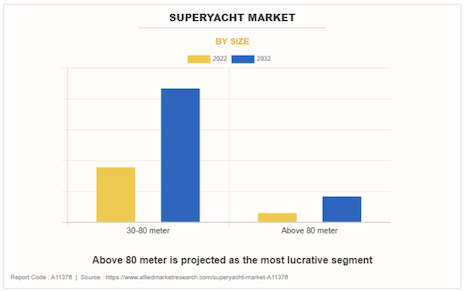 Superyachts longer than 80 meters are expected to be the most lucrative segment in the period ahead. Source: Allied Market Research
Superyachts longer than 80 meters are expected to be the most lucrative segment in the period ahead. Source: Allied Market Research
Events and collabs drive experiences
Yacht exhibitions and events such as the Monaco Yacht Show, Dubai Yacht Show and the Palm Beach International Boat Show have a huge impact on brand building and improving a company's reputation in the superyacht industry.
A brand's participation in prestigious events strengthens its exclusivity and credibility, as well as its position as a dominant force in the industry.
“Manufacturers who regularly participate in prestigious events demonstrate their commitment to innovation and perfection, which increases the attractiveness of their products and gives hope to potential consumers,” the report said.
Collaboration between superyacht manufacturers and other luxury companies is also facilitated through yacht shows and events. Exclusive and bespoke boating projects are realized by collaborating with luxury watchmakers, fashion designers, interior designers and car makers, bringing about an integration of luxury experiences.
Sustainability to the fore
In countries such as Italy, United Kingdom, Spain and Germany, the industry is witnessing a surge in the popularity of sustainable and eco-friendly yachting, aligning with the region's strong emphasis on environmental conservation.
In addition, manufacturers in Europe are now venturing into sustainable development and have increased their efforts to produce environment-friendly yachts.
For instance, in January 2022, Pascoe International announced the sale of the world's first 100 percent electric superyacht limousine tender.
Additionally, the company has confirmed the new tender is now under construction. The vessel, which is being made at a major Northern European shipyard, is set for delivery to a large newly built mothership in 2023.
As Europe remains a hub for high-net-worth individuals and luxury travel, the superyacht industry in the region is well-positioned for sustained growth and continued prominence on the global stage, per the report.
Maritime history and high-skill craftsmanship, as well as modern designing, made Italy a desirable place for yacht owners with good taste. This development arises from the combination of ancient handcrafting skills, along with contemporary technology.
However, Italian shipyards have always supplied elegant yet ultra-modern vessels of high quality, boasting good ports and a central location that strategically places Italy in a position to supply the fast-growing external markets.
The country's commitment to research and development, coupled with its emphasis on fostering international collaborations, further enhances its competitive edge.
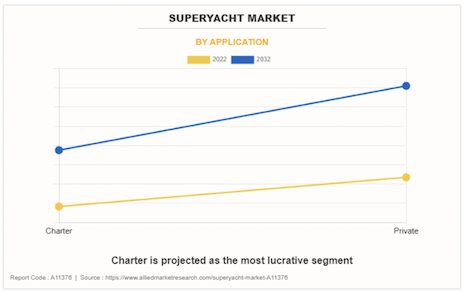 Charter is another segment that is project to be the most lucrative in the superyacht sector. Source: Allied Market Research
Charter is another segment that is project to be the most lucrative in the superyacht sector. Source: Allied Market Research
For instance, in February 2023, The Italian Sea Group (TISG) and Italian fashion designer Giorgio Armani revealed their 72-metre superyacht collaboration, currently in build, at a star-studded gala evening at the shipyard’s headquarters in Marina di Carrara.
The interior is by Armani/Casa and uses a soft and minimalist palette that contrasts the use of refined materials and handcrafted finishes. The first interior renderings show polished marble floors with gold accents and occasional use of dark wood.
Key developments
Leading superyacht manufacturers are adopting strategies such as acquisition, agreement, expansion, partnership, contracts and product launches to strengthen their market position.
In July 2023, Damen Yachting launched four Amels 60 superyachts. The 60m, 830 GT Amels 60 superyacht features an exterior design by Espen oino, naval architecture by Damen Yachting and a custom interior by two collaborating studios, Studio Indigo and Pure Living. It offers six staterooms for up to 12 guests.
In November 2022, Damen Yachting expanded its service in the Gorinchem yard that includes additional repair facilities and a 150-ton ship lift. The group aims for the updated shipyard in Gorinchem to turn into an optimal location for the design, maintenance, repair, conversion and building of new ships of up to 90 meters, while its Hardinxveld-Giessendam yard was divested before the project’s completion.
In June 2021, San Lorenzo developed a 44-meter superyacht model named the X-Space. The X-Space features a 495GT interior and is designed specifically around privacy, with the upper deck dedicated to the owner. This deck includes a private apartment, study, living room and large master cabin.
In March 2020, Ferretti SpA launched Ferretti 1000 yachts. The first model hit the water from Ferretti Yachts' Cattolica-based facility in Italy.
In March 2020, San Lorenzo launched the SX112 crossover yacht and the 44Alloy and 62Steel superyachts. SX112 comes with 34m length and a flagship SX crossover line that proposes a new way of living on the sea: the barriers on board are eliminated, and the boat opens to the outside, in a close relationship with the marine context.
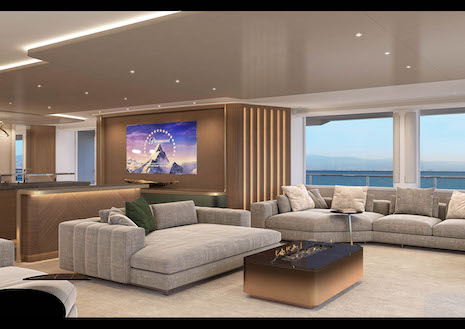 The SkyFall Lounge on Heesen's Project Ultra G superyacht. Image: Heesen
The SkyFall Lounge on Heesen's Project Ultra G superyacht. Image: Heesen
Growth in the nautical tourism industry
Nautical tourism is a specialized form of tourism that involves recreational activities and travel undertaken on water. It encompasses a wide range of activities and destinations related to boating, sailing, yachting, cruising and other maritime experiences.
Yachting along coastal locations is slowly becoming popular across various countries.
Nautical tourism, characterized by the exploration of coastal and maritime destinations using luxury vessels, has become a driving force behind the increased demand for superyachts, per the report.
High-net-worth individuals are increasingly drawn to the allure of unique and exclusive travel experiences, seeking the freedom to explore picturesque coastlines, hidden coves, and exotic island destinations in unparalleled luxury.
Superyachts, equipped with state-of-the-art amenities and crewed by skilled professionals, provide an ideal platform for travelers to indulge in tailor-made itineraries, exploring pristine coastlines and hidden gems inaccessible to conventional forms of transportation.
“As the allure of nautical tourism continues to captivate the elite global traveler, the demand for superyachts is set to flourish, making them not only vessels of luxury but also essential conduits for a bespoke and unforgettable maritime tourism experience,” per the report.
Rising global wealth
A growing global UHNW class is turning to extravagant experiences as their wealth affords a no-barred lifestyle.
For example, a report by Henley & Partners (2022) reveals that the number of what the company calls centi-millionaires increased to 28,420 globally, up by 12 percent since the last year. This wealth growth is evident in Asia, Middle East and developing countries, in general, and has led to increased demand for superyachts.
These vessels, often considered the ultimate status symbols, appeal to individuals who desire not only a means of luxurious travel but also a tangible representation of their success and lifestyle.
The superyacht market benefits from the discretionary spending of this affluent demographic, as these individuals seek exclusive and tailor-made experiences that go beyond conventional travel.
The desire to stand out in a crowd, coupled with the appeal of owning a floating sanctuary equipped with the latest technological innovations and lavish amenities, aligns perfectly with the aspirations of the newly wealthy.
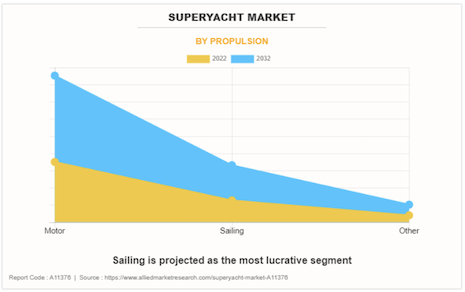 Sailing is gaining popularity among UHNW consumers, boosting demand for superyachts that travel to unique places with distinct experiences. Source: Allied Market Research
Sailing is gaining popularity among UHNW consumers, boosting demand for superyachts that travel to unique places with distinct experiences. Source: Allied Market Research
High price and maintenance cost
The purchase of a super yacht is typically very expensive, sometimes costing well over $100 million, making it a privilege reserved mainly for the extremely rich.
The high costs involved in buying it serves as a form of barrier into the industry.
In addition, the ongoing maintenance costs, encompassing crew salaries, fuel, insurance, dockage fees and regular repairs, contribute significantly to the total cost of ownership.
An estimated 10-15 percent of the purchase price is spent annually on operating and maintaining a yacht. That is $1-1.5 million a year for a $10 million yacht.
Also, routine maintenance can cost roughly 2 percent of the yacht's value after the yacht's first year, and around 7.5 percent of the yacht's value when the yacht is 10 years old.
Thus, such financial burden can dissuade even affluent individuals from venturing into the superyacht market, as the associated expenses extend far beyond the initial purchase.
The combination of high acquisition costs and the ongoing financial commitments for operation and maintenance can limit the potential customer base, hindering the market's broader growth.
Efforts to mitigate these challenges often involve innovations in financing models, shared ownership structures, and the development of more cost-effective operational practices to make superyacht ownership more accessible and sustainable for a wider audience.
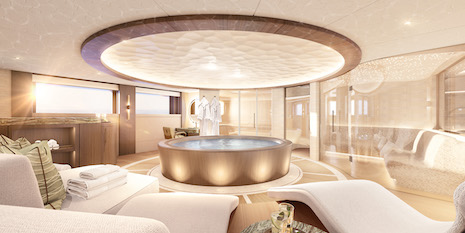 Spa on Heesen's Project Sparta superyacht. Image: Heesen
Spa on Heesen's Project Sparta superyacht. Image: Heesen
Increase in technological advancements and design
The integration of cutting-edge technology has become a hallmark of superyacht design, with a focus on enhancing both the onboard experience and the overall performance of these vessels.
Advanced navigation systems, satellite communication and automation technologies contribute to safer and more efficient maritime travel, while smart home automation systems cater to the desires of owners for seamless control of onboard amenities.
For example, in September 2023, in Botany, New South Wales, the UTS Tech Lab facility scaled up the manufacturing of the Advanced Navigationa world-first AI navigation systems for GPS-denied environments, including its digital fiber-optic gyroscope (DFOG) technology, Boreas.
“Furthermore, superyacht designers are pushing the boundaries of creativity, creating vessels that not only exude elegance but also maximize space and utility,” the report said.
“Open and flexible layouts, large windows and innovative use of materials contribute to a sense of openness and connection with the sea.
“Moreover, there is a growing emphasis on sustainability in design, with the integration of eco-friendly materials, energy-efficient systems and even hybrid propulsion technologies. This reflects an industry-wide commitment to environmental responsibility, addressing the concerns of both owners and the broader public.”
